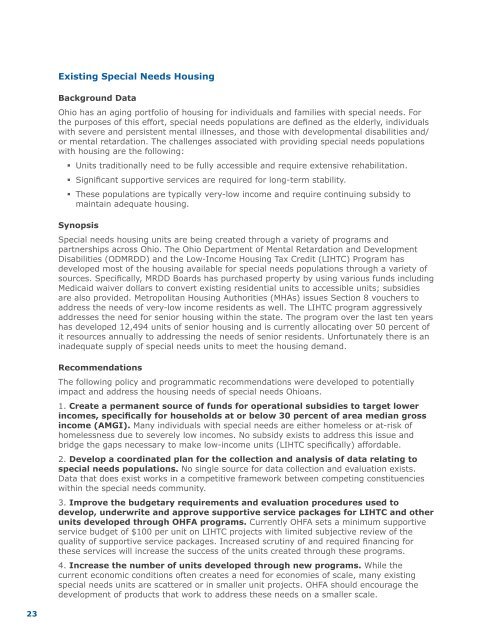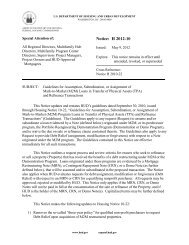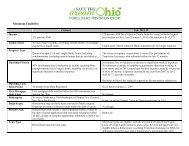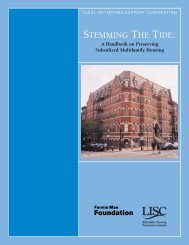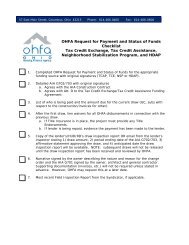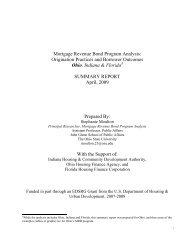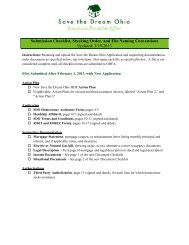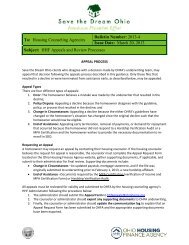OHFA Annual Plan - Ohio Housing Finance Agency
OHFA Annual Plan - Ohio Housing Finance Agency
OHFA Annual Plan - Ohio Housing Finance Agency
You also want an ePaper? Increase the reach of your titles
YUMPU automatically turns print PDFs into web optimized ePapers that Google loves.
Existing Special Needs <strong>Housing</strong>Background Data<strong>Ohio</strong> has an aging portfolio of housing for individuals and families with special needs. Forthe purposes of this effort, special needs populations are defined as the elderly, individualswith severe and persistent mental illnesses, and those with developmental disabilities and/or mental retardation. The challenges associated with providing special needs populationswith housing are the following:• Units traditionally need to be fully accessible and require extensive rehabilitation.• Significant supportive services are required for long-term stability.• These populations are typically very-low income and require continuing subsidy tomaintain adequate housing.SynopsisSpecial needs housing units are being created through a variety of programs andpartnerships across <strong>Ohio</strong>. The <strong>Ohio</strong> Department of Mental Retardation and DevelopmentDisabilities (ODMRDD) and the Low-Income <strong>Housing</strong> Tax Credit (LIHTC) Program hasdeveloped most of the housing available for special needs populations through a variety ofsources. Specifically, MRDD Boards has purchased property by using various funds includingMedicaid waiver dollars to convert existing residential units to accessible units; subsidiesare also provided. Metropolitan <strong>Housing</strong> Authorities (MHAs) issues Section 8 vouchers toaddress the needs of very-low income residents as well. The LIHTC program aggressivelyaddresses the need for senior housing within the state. The program over the last ten yearshas developed 12,494 units of senior housing and is currently allocating over 50 percent ofit resources annually to addressing the needs of senior residents. Unfortunately there is aninadequate supply of special needs units to meet the housing demand.RecommendationsThe following policy and programmatic recommendations were developed to potentiallyimpact and address the housing needs of special needs <strong>Ohio</strong>ans.1. Create a permanent source of funds for operational subsidies to target lowerincomes, specifically for households at or below 30 percent of area median grossincome (AMGI). Many individuals with special needs are either homeless or at-risk ofhomelessness due to severely low incomes. No subsidy exists to address this issue andbridge the gaps necessary to make low-income units (LIHTC specifically) affordable.2. Develop a coordinated plan for the collection and analysis of data relating tospecial needs populations. No single source for data collection and evaluation exists.Data that does exist works in a competitive framework between competing constituencieswithin the special needs community.3. Improve the budgetary requirements and evaluation procedures used todevelop, underwrite and approve supportive service packages for LIHTC and otherunits developed through <strong>OHFA</strong> programs. Currently <strong>OHFA</strong> sets a minimum supportiveservice budget of $100 per unit on LIHTC projects with limited subjective review of thequality of supportive service packages. Increased scrutiny of and required financing forthese services will increase the success of the units created through these programs.4. Increase the number of units developed through new programs. While thecurrent economic conditions often creates a need for economies of scale, many existingspecial needs units are scattered or in smaller unit projects. <strong>OHFA</strong> should encourage thedevelopment of products that work to address these needs on a smaller scale.23


